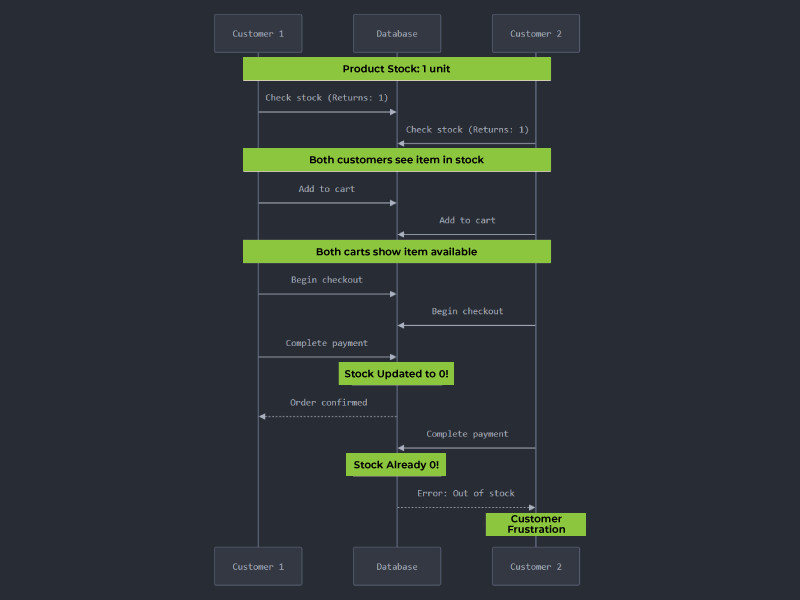What is a race condition?
A race condition occurs in concurrent systems where the output or behaviour of the system depends on the relative timing or order of two or more events.
In e-commerce, race conditions can lead to critical issues such as overselling, stock discrepancies, and lost revenue. In this article, we will understand Race Condition Vulnerabilities and Security Best Practices.
How do race conditions occur in e-commerce?
Race conditions in e-commerce often arise when multiple users or processes attempt to simultaneously access and update shared resources, such as product inventory or coupon codes.
If the system does not correctly manage these concurrent access requests, inconsistent data and unintended outcomes can result.

Real-world examples of race conditions in e-commerce
Coupon Code Abuse: Multiple customers simultaneously attempting to redeem the same limited-time coupon code can lead to the coupon being used by more customers than intended.
Inventory Depletion: Customers adding the same product to their carts simultaneously can oversell the product, leading to customer disappointment and brand damage.
Checkout Conflicts: Customers trying to checkout with the same product simultaneously can cause issues updating the inventory and processing the orders correctly.
The Impact of Race Conditions on E-commerce Businesses
Overselling and stock discrepancies
When race conditions occur, e-commerce businesses may sell more units of a product than they have in stock, leading to overselling and frustrated customers.
Lost revenue and customer dissatisfaction
Unresolved race conditions can result in lost sales opportunities, refunds, and damaged customer relationships due to unfulfilled orders and poor customer experiences.
Damaged brand reputation
Repeated issues with race conditions can significantly erode customer trust and tarnish an e-commerce business’s reputation, making it harder to attract and retain customers.
Legal implications
Depending on the severity and frequency of race condition-related issues, e-commerce businesses may face legal consequences, such as customer lawsuits or regulatory fines.
Common Scenarios Prone to Race Conditions
High-traffic sales events
During peak shopping seasons or flash sales, many customers attempting to access limited-stock items can trigger race conditions.
Limited-time offers and flash sales
Promotional offers with strict time limits or limited availability are particularly vulnerable to race conditions, as customers race to secure discounted items.
Inventory management systems
Poorly designed or implemented inventory management systems can fail to properly handle concurrent updates, leading to race conditions and stock discrepancies.
Checkout processes
The checkout process, where customers complete their purchases, is a critical point where race conditions can occur if not properly managed.
Strategies to Prevent Race Conditions
How can stores stop this? Here are some methods,
Improved Database: The system can treat essential actions as a single step, preventing gaps for attackers.
Smart Programming: Special tools can lock parts of the system while updates happen, stopping other actions from interfering.
Organized Architecture: Having one central source of information and processing requests in order makes it harder to exploit gaps.
Optimistic Concurrency Control
Version numbers: Assign version numbers to data objects and only allow updates if the version number matches the current version.
Timestamp-based concurrency control: Use timestamps to determine the most recent data version and only allow updates to the latest version.
Pessimistic Concurrency Control
Database locks: Acquire exclusive locks on data objects before updating them to prevent concurrent access.
Distributed locks: Use a centralised locking mechanism like a distributed lock service to coordinate access to shared resources.
Other Strategies
Queuing systems: Use message queues or job queues to handle concurrent requests in a controlled, sequential manner.
Asynchronous processing: Offload time-consuming tasks to background processes to avoid blocking the main request-handling flow.
Redundancy and failover mechanisms: Implement redundant systems and failover mechanisms to ensure availability and consistency in the face of race conditions.
Best Practices for E-commerce Developers
How Stores Can Find and Fix Weaknesses
- Testing Response Times: Seeing if the system reacts too slowly in certain situations can reveal vulnerabilities.
- Simulating Attacks: Security experts can try to exploit gaps with special tools to see if they exist.
- Monitoring Activity: Keeping an eye on unusual request patterns can help identify suspicious behaviour.
Regular code reviews and audits
Conduct regular code reviews and security audits to catch race condition vulnerabilities early in development.
Stay updated with the latest technologies and frameworks
Keep your e-commerce tech stack up-to-date with the latest security patches and best practices for concurrency control.
Collaborate with security experts
Engage with security professionals to ensure your e-commerce systems are designed and implemented with robust race condition mitigation strategies.
Conclusion
Race conditions pose a significant threat to the stability and success of e-commerce businesses.
By understanding the root causes of these issues, implementing effective prevention strategies, and adopting best practices, e-commerce sellers can mitigate the risk of overselling, lost revenue, and damaged brand reputation.
As the e-commerce landscape evolves, staying vigilant and proactive in addressing race conditions will be crucial for e-commerce businesses to thrive in the highly competitive online marketplace.









